-
Friends, our 2nd Amendment rights are always under attack and the NRA has been a constant for decades in helping fight that fight.
We have partnered with the NRA to offer you a discount on membership and Muzzleloading Forum gets a small percentage too of each membership, so you are supporting both the NRA and us.
Use this link to sign up please; https://membership.nra.org/recruiters/join/XR045103
You are using an out of date browser. It may not display this or other websites correctly.
You should upgrade or use an alternative browser.
You should upgrade or use an alternative browser.
How full should the pan be?
- Thread starter M. De Land
- Start date

Help Support Muzzleloading Forum:
This site may earn a commission from merchant affiliate
links, including eBay, Amazon, and others.
Rifleman1776 said:ebiggs said:Rifleman1776 said:But on the matter of prime the larger the “footprint” it has the greater chance the spark will hit a good spot for “reliable” ignition.
Covering the touch does not slow ignition. Even some trickling in is a good thing.
Use enough and don't skimp om it. It's cheap!
Here we go again.
Completely disagree. A good lock will give all the spark contact with powder you need.
Less primer powder the quicker the ignition. Too much powder will require time for it to burn down before the heat reaches the touchhole.
The actual barrel ignition is not causes so much by the primer burning into the barrel as a sort of venturi effect bringing the heat to the main charge.
Unfortunately for you,this time anyway, is modern testing, cameras and computers prove you are mistaken. As are all the rest that think less is more and against the touch hole is bad.
Also the position of the touch hole has a best placement spot for sure, but it is not a deal breaker if it is not exactly located. Another old wives tale blow away with modern testing equipment.
Mr. Phariss is absolutely correct and I agree totally with him on this subject. :thumbsup:
Now you guys are free to use whatever you like but the facts are what they are. :shake:
I guess this could go on forever. I respect Dan's testing.
But, I also recognize a "Ph-s-s-s-s-s-s-s-boom" and an instant "boom".
My favorite rifle (the one that likes sawn flints) is as quick (by my ears) as my bolt action 30-06 with a tiny trickly of prime along the bottom of the pan and not near the touch hole.
Piled up there is a noticable burn/lag time, not quick at all.
Again, its physically impossible for a flintlock to be as fast as any decent percussion much less any modern bolt action.
Simple way to ascertain this is to watch Larry's videos of flintlocks igniting the prime. One of those featured the fastest lock they timed, is an original Manton probably from the 1820s. The cock falls, the flint strikes the frizzen and scrapes down it. It throws sparks in the powder. They set there then the powder STARTS to ignite. The flame propagates through the priming.
If the barrel was loaded, when enough heat is generated and radiated through the vent it will ignite the main charge.
This is the sequence when viewed in ultra slow-mo.
Its easy to find on Larry's web site linked in my last post.
This actual firing slowed to 30 fps (IIRC) converted from a video my daughter shot. http://s72.photobucket.com/albums/i199/DPhariss/Video 1/?action=view¤t=SLOWMOTION.mp4
Note the time between the cock moving and the charge firing. Both these are very fast flintlocks by anyone's timer. Stiff springs and low friction internals.
That the timing and ultra slow mo interferes with someones long held beliefs?
That is not the concern. The goal for Larry was to do the research to find out what is real and what is not. Some people used to swear the earth was flat too.
People can LOOK at the videos and LOOK at the timing data and make their own judgements.
Anyone that is at odds with the data needs to get the equipment and do their OWN timing and ultra slow-mo to show us that Larry, who as been at this for YEARS, is fundamentally wrong.
I have never had a pan of dry powder FFSSSTT. This is usually the sign of a main charge igniting through a vent that is wet as a result of improper wiping before loading. Yeah BTDT too....
The FSSST is damp powder burning through to the dry part of the charge. Which then fires normally.
Or its really bad priming powder.
Dan
Last edited by a moderator:
Larry Pletcher
50 Cal.
- Joined
- Jul 27, 2006
- Messages
- 1,313
- Reaction score
- 67
Dan mentioned the dreaded "FFSSSTT". In 20 years of timing, my gut says that the vast majority of "FFSSSTT" are vent related - this assumes that priming powder is good and the flint edge is maintained. I have photos that show the gradual buildup of fouling in vents that accumulates during a test session. In one vent, I used a drill bit to push out a tiny "tube" of fouling that lined the vent. The vent opening was closed down significantly by fouling.
Maybe you have watched a shooter have a hangfire and try to remedy it by knapping his flint and leaving his vent untouched. It makes sense until you think about it.
You have heard the old sayings like "Mind your scalp" or "mind your topknot". I think they should have been saying " Mind your vent" or Mind your flint edge."
No tests in this post - just gut reaction.
Regards,
Pletch
Maybe you have watched a shooter have a hangfire and try to remedy it by knapping his flint and leaving his vent untouched. It makes sense until you think about it.
You have heard the old sayings like "Mind your scalp" or "mind your topknot". I think they should have been saying " Mind your vent" or Mind your flint edge."
No tests in this post - just gut reaction.
Regards,
Pletch
It is amazing how hard it is for these old beliefs to die off. Some of us have done it that way for years, or even all our lives, and find what we thought was best was incorrect.
The human eyes and ears are profoundly poor sensors for producing the true facts.
I will point out one issue that I caught on to very early in reading Mr. Pletcher's experiments. He uses a hot wire to ignite the prime. He did so to make each test just a timing of the prime.
But in common use by all of us the is an actual flint involved. A poor flint may not produce any sparks until it is quite a way down the frizzen. More time added! A very good flint, yes, possibly Mr. Fusco's swan agates, produce a spark higher up on the frizzen. Shorter time elapsed, quicker shot, not necessarily due to the prime.
As I have always said all these methods are accumulative. Do any one of them and you probably can not tell or see the difference. But start adding several or even just two and you may well see the slow down. For instance is 4F faster than 3F, yes it is. Can you humanly tell the difference. Probably not.
But use 3F, a dull flint and bank away from the touch hole and, yes a definite lag is easily detected by virtually everyone.
My advice use the best and fastest all the time.
The human eyes and ears are profoundly poor sensors for producing the true facts.
I will point out one issue that I caught on to very early in reading Mr. Pletcher's experiments. He uses a hot wire to ignite the prime. He did so to make each test just a timing of the prime.
But in common use by all of us the is an actual flint involved. A poor flint may not produce any sparks until it is quite a way down the frizzen. More time added! A very good flint, yes, possibly Mr. Fusco's swan agates, produce a spark higher up on the frizzen. Shorter time elapsed, quicker shot, not necessarily due to the prime.
As I have always said all these methods are accumulative. Do any one of them and you probably can not tell or see the difference. But start adding several or even just two and you may well see the slow down. For instance is 4F faster than 3F, yes it is. Can you humanly tell the difference. Probably not.
But use 3F, a dull flint and bank away from the touch hole and, yes a definite lag is easily detected by virtually everyone.
My advice use the best and fastest all the time.
“My favorite rifle (the one that likes sawn flints) is as quick (by my ears) as my bolt action 30-06 ...”
And a perfect example of why you should not and can not trust your senses to justify the speed of the gun. As you and I know this is impossible.
Flash Pan Dan
45 Cal.
- Joined
- Jun 21, 2010
- Messages
- 810
- Reaction score
- 6
Pletch, Dan, and Ebiggs, Thank you all for being the voice of reason. I have been grinding my teeth about this thread waiting for you all to chime in with the links and results from actual empirical testing and experience. I have modified my way of loading the pan and setting up my locks and vents after reading and watching Pletch’s test results and have found them to me accurate in my own testing.
I am one of the few people shooting a flintlock in my area and I have won my share of local matches, I still get into the same arguments with folks who argue the same way; less is more, pile away from the vent, etc. I keep beating them and people tell me how much faster my locks go off than theirs, but still the myths persist.
I am being a little more philosophical now, I no longer feel I am butting heads against myth and unreasoning subjective perceptions but plain old human nature. As always people are going to do, what they do, the way the do, because of how they have always done things regardless of facts or reason. I know I do in certain areas of my life still.
I am one of the few people shooting a flintlock in my area and I have won my share of local matches, I still get into the same arguments with folks who argue the same way; less is more, pile away from the vent, etc. I keep beating them and people tell me how much faster my locks go off than theirs, but still the myths persist.
I am being a little more philosophical now, I no longer feel I am butting heads against myth and unreasoning subjective perceptions but plain old human nature. As always people are going to do, what they do, the way the do, because of how they have always done things regardless of facts or reason. I know I do in certain areas of my life still.
hanshi
Cannon
Those things do have to be watched and I've been caught being distracted from time to time. Locks such as the Siler have rather small pans and the equivalent of one push of a 4F filled brass thingy is more than enough (myself). Truly big locks such as the Colonial Va lock on my fowler, easily take two to three times as much prime for the same area coverage. And I use two or three pushes on the primer spout for that gun. I think what it boils down to is being confident in the type and amount of prime one uses.
The " FFSSSTTBOOM" does happen.
It has happened to me on several occasions, all with the same gun.
The main charge was dry 3Fg powder.
The prime was dry 3Fg powder.
The flint was sharp and the lock threw enough sparks that the prime would ignite easily.
The rifle did not have a replaceable vent in it. Rather, it had a fairly small vent hole drilled thru the barrel wall.
When priming this gun, being new to the world of flintlocks I had filled the pan and at least partially filled the vent hole.
When the trigger was pulled I could hear the flint hit the frizzen and almost immediately the prime in the pan lit.
There was a noticable audio sound of a FSSSSSSS before the main powder charge fired. It sounded exactly like a very short fuse on a firecracker.
Of course I wasn't timing it but it had to last well over a few tenths of a second for it to register on my brain.
Yes, I've read and watched the results of Pletch's great research but his not noting this delayed ignition does not prove it doesn't happen.
It only proves it didn't happen to him during his tests.
It has happened to me on several occasions, all with the same gun.
The main charge was dry 3Fg powder.
The prime was dry 3Fg powder.
The flint was sharp and the lock threw enough sparks that the prime would ignite easily.
The rifle did not have a replaceable vent in it. Rather, it had a fairly small vent hole drilled thru the barrel wall.
When priming this gun, being new to the world of flintlocks I had filled the pan and at least partially filled the vent hole.
When the trigger was pulled I could hear the flint hit the frizzen and almost immediately the prime in the pan lit.
There was a noticable audio sound of a FSSSSSSS before the main powder charge fired. It sounded exactly like a very short fuse on a firecracker.
Of course I wasn't timing it but it had to last well over a few tenths of a second for it to register on my brain.
Yes, I've read and watched the results of Pletch's great research but his not noting this delayed ignition does not prove it doesn't happen.
It only proves it didn't happen to him during his tests.
Larry Pletcher
50 Cal.
- Joined
- Jul 27, 2006
- Messages
- 1,313
- Reaction score
- 67
Zonie said:The " FFSSSTTBOOM" does happen.
It has happened to me on several occasions, all with the same gun.
The main charge was dry 3Fg powder.
The prime was dry 3Fg powder.
The flint was sharp and the lock threw enough sparks that the prime would ignite easily.
The rifle did not have a replaceable vent in it. Rather, it had a fairly small vent hole drilled thru the barrel wall.
When priming this gun, being new to the world of flintlocks I had filled the pan and at least partially filled the vent hole.
When the trigger was pulled I could hear the flint hit the frizzen and almost immediately the prime in the pan lit.
There was a noticable audio sound of a FSSSSSSS before the main powder charge fired. It sounded exactly like a very short fuse on a firecracker.
Of course I wasn't timing it but it had to last well over a few tenths of a second for it to register on my brain.
Yes, I've read and watched the results of Pletch's great research but his not noting this delayed ignition does not prove it doesn't happen.
It only proves it didn't happen to him during his tests.
Zonie,
We're in complete agreement. The example you cite is exactly what I was refering to in my first paragraph when I said "Dan mentioned the dreaded "FFSSSTT". In 20 years of timing, my gut says that the vast majority of "FFSSSTT" are vent related - this assumes that priming powder is good and the flint edge is maintained. I have photos that show the gradual buildup of fouling in vents that accumulates during a test session. In one vent, I used a drill bit to push out a tiny "tube" of fouling that lined the vent. The vent opening was closed down significantly by fouling."
In your case, the lock, flint edge, and priming powder did just fine. The delay was after the prime ignited and before the barrel charge ignited. This is what I meant about delays being vent related. While I feel that a tiny, long, cylinder vent is more likely to cause delays, all can do this under certain conditions.
In the example I mentioned above when I pushed out a "tube" of fouling, we had done numerous firings, and the vent was not cleaned. It was a larger diameter vent, but I'd guess that the same "tube" of fouling could build up in small diameter vents too. So, my guess is that the delay you experienced could have been a combination of fouling in a small, unforgiving vent. I'd also "guess" that this delay wasn't on the first shot of the day.
In tests that I've done I haven't experienced delays caused by priming in the vent. I also take unusual means to prevent fouling causing delays. The last step before loading in many tests was to blow compressed air through the vent to get rid of any possible fouling - an advantage in tests that aren't reasonable for a shooter.
Your example brings up a future area for testing. Maybe a test where vent cleaning is not done, and we time to see if the ignition speed or realiability suffers. Normally I try to eliminate fouling problems. Maybe a test needs to be done to induce fouling problems. I'm curious if you have any ideas about ways to do this.
Regards,
Pletch
The priming in the pan does NOT "FSSST" unless there is a problem with the powder.
The "Fsst" is gas escape from the vent.
Having proved a number of FL barrels there is a "vent pop" from standard breeches as the barrel fires. In this case with a fuse and powder at the vent.
This vent pop is a pressure wave, probably supersonic, exiting the vent.
As I have stated and Pletch has too the "FSSST" is SURELY vent related. UNLESS the prime is wet or extremely large grained.
The worse "FFFSSSTTT" I ever had was at Granger Wy in a match. It was hot and dry as it usually is in the east slope region in summer. I ran a wet patch in the bore and since the barrel was hot did not worry about reloading. The patch was TOO wet. When I seated the ball it pushed wet fouling out the vent into the pan (great thinks I ). I figure what the heck wipe the pan prime heavily. Aim trip the trigger and hold through the long "FFFSSSSSTTTTT" and got the target.
). I figure what the heck wipe the pan prime heavily. Aim trip the trigger and hold through the long "FFFSSSSSTTTTT" and got the target.
I virtually never get a "FSSST" if the vent is not obstructed the gun fires if the pan does. UNLESS its wet. If the vent is obstructed its a flash. Hangs are invariably flint related unless the vent is very dirty/partly obstructed or the vent is damp and slows the initial light off of the main charge.
I make my own liners and have for years. They are much like a White Lightning with minor changes internally depending on the barrel/breech design.
Ideally the vent looks like this when loaded.
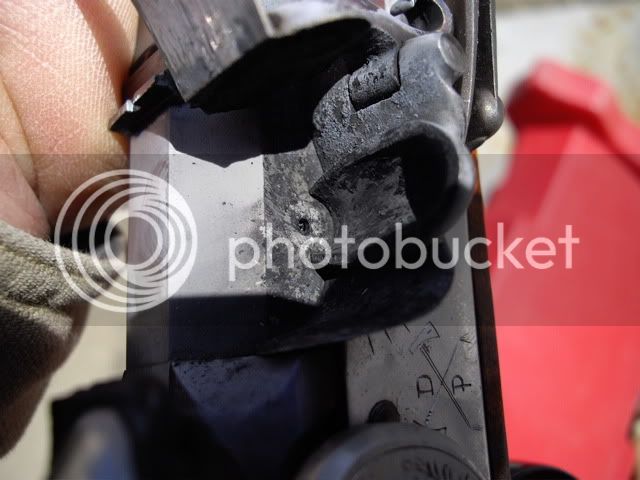
I never pick a vent unless it becomes obstructed.
The reason is obvious.
This the same vent. When freshly installed and I dumped in some powder just to photograph it.
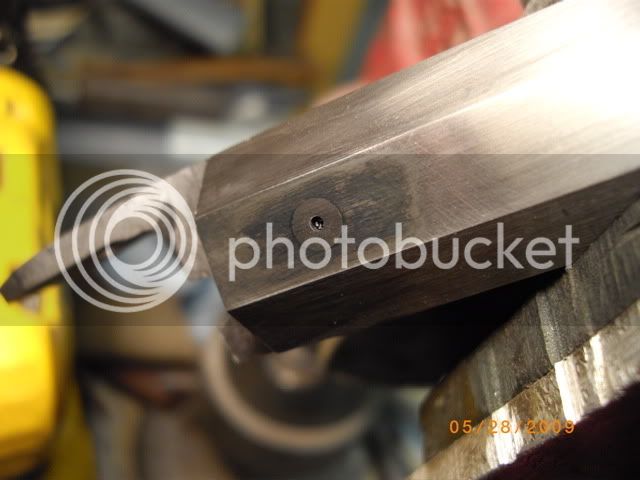
To install the barrel is drilled and counter bored
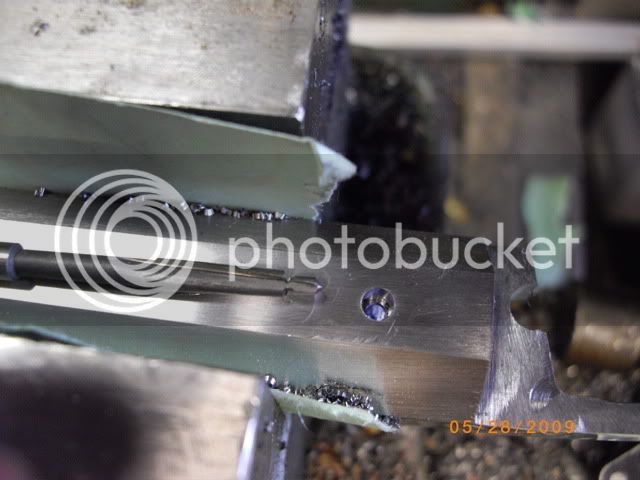
Then tapped

Magic marker is used to fit everything properly at both the internal and external shoulder (the internal shoulder reduces pressure on the threaded joint by a considerable amount making the vent more secure.
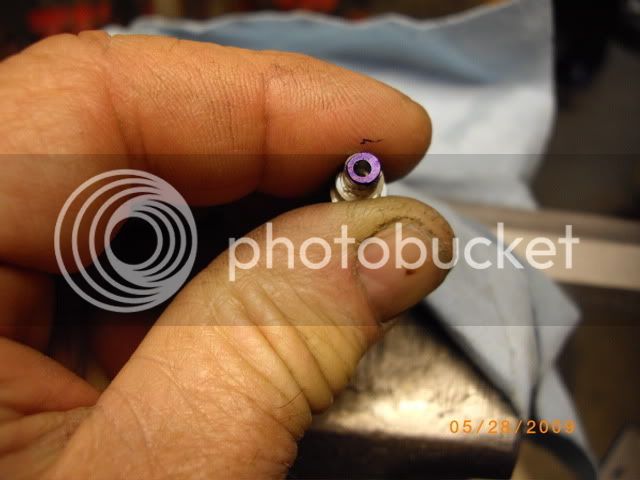
Once fitted properly and snugged down its filed flush.
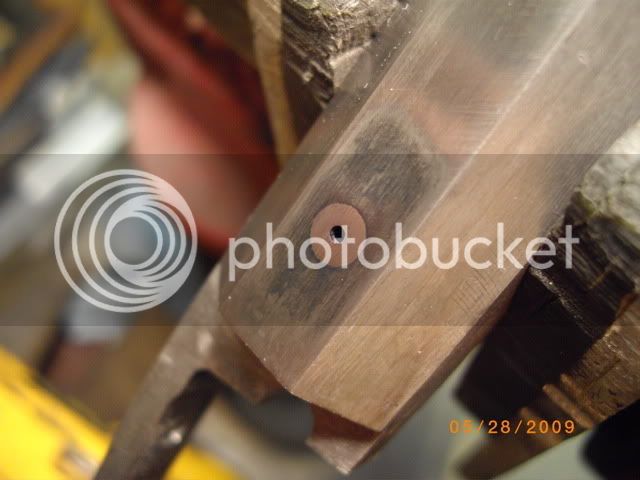
Careful calculation with drilling will result in a .030" or so "web" between the pan and the counter bore inside the vent.
Dan
The "Fsst" is gas escape from the vent.
Having proved a number of FL barrels there is a "vent pop" from standard breeches as the barrel fires. In this case with a fuse and powder at the vent.
This vent pop is a pressure wave, probably supersonic, exiting the vent.
As I have stated and Pletch has too the "FSSST" is SURELY vent related. UNLESS the prime is wet or extremely large grained.
The worse "FFFSSSTTT" I ever had was at Granger Wy in a match. It was hot and dry as it usually is in the east slope region in summer. I ran a wet patch in the bore and since the barrel was hot did not worry about reloading. The patch was TOO wet. When I seated the ball it pushed wet fouling out the vent into the pan (great thinks I
 ). I figure what the heck wipe the pan prime heavily. Aim trip the trigger and hold through the long "FFFSSSSSTTTTT" and got the target.
). I figure what the heck wipe the pan prime heavily. Aim trip the trigger and hold through the long "FFFSSSSSTTTTT" and got the target.I virtually never get a "FSSST" if the vent is not obstructed the gun fires if the pan does. UNLESS its wet. If the vent is obstructed its a flash. Hangs are invariably flint related unless the vent is very dirty/partly obstructed or the vent is damp and slows the initial light off of the main charge.
I make my own liners and have for years. They are much like a White Lightning with minor changes internally depending on the barrel/breech design.
Ideally the vent looks like this when loaded.

I never pick a vent unless it becomes obstructed.
The reason is obvious.
This the same vent. When freshly installed and I dumped in some powder just to photograph it.

To install the barrel is drilled and counter bored

Then tapped

Magic marker is used to fit everything properly at both the internal and external shoulder (the internal shoulder reduces pressure on the threaded joint by a considerable amount making the vent more secure.

Once fitted properly and snugged down its filed flush.

Careful calculation with drilling will result in a .030" or so "web" between the pan and the counter bore inside the vent.
Dan
I had a heck of a time working up a prime load in my first flint lock. Finally I bought a 1 grain and a 3 grain throwing tip. I put each in an antler tip with 4F. One and two grains just wasnt enough in my lock. The 3 grain was reliable every time. So I stopped there and called it good. Every lock is different. Keep trying unti you find what works
I gave up on the little plunger primer valves a couple of years ago after using one for 25-30 years. They can get compressed in the pouch and leak and the tend to get gummed up with fouling when priming fouled pans.
I went back to a small horn. In shooting FLs for over 40 years I have never once paid any attention to what weight of prime I used.
Bottom line? The rifle MUST fire when the trigger is pulled. I have not have a flash in the pan hunting in at least 25 years. I do have them occasionally when shooting matches because I tend to ignore the vent. When hunting I don't shoot 10-20 rounds in a day so fouling is not a factor.
Dan
I went back to a small horn. In shooting FLs for over 40 years I have never once paid any attention to what weight of prime I used.
Bottom line? The rifle MUST fire when the trigger is pulled. I have not have a flash in the pan hunting in at least 25 years. I do have them occasionally when shooting matches because I tend to ignore the vent. When hunting I don't shoot 10-20 rounds in a day so fouling is not a factor.
Dan
- Joined
- Dec 25, 2011
- Messages
- 8,998
- Reaction score
- 4,073
Good plan Dan, I set up my nipple the same way in my underhammer gun leaving the shoulder at the bottom. MD
Larry Pletcher
50 Cal.
- Joined
- Jul 27, 2006
- Messages
- 1,313
- Reaction score
- 67
ebiggs said:. . . .
The human eyes and ears are profoundly poor sensors for producing the true facts.
I will point out one issue that I caught on to very early in reading Mr. Pletcher's experiments. He uses a hot wire to ignite the prime. He did so to make each test just a timing of the prime.
But in common use by all of us the is an actual flint involved.
ebiggs,
I thought I should make part of my methods more specific. When I time locks, flints, priming powder, I do use flints as usual. In these cases I'm interested in how quickly the pan ignites.(Time stops when the pan ignites.)
Times when I use a hot copper wire are when I'm timing barrel ignition, specifically vents, vent location, and priming position in the pan. In these cases I'm interested in starting time with pan ignition and ending with barrel ignition. If I want the time to start with pan ignition, I don't want the flint variables to enter the picture.
In one case I wanted to time the whole picture from sear to barrel ignition . Obviously here I use flints. Time starts when the sear is touched by the plunger and ends with barrel ignition.
Thought I should clarify the situations and reasons for using the wire vs the flints.
Regards,
Pletch
PS - I should mention that only once did I get the "PSSSST" when timing only the lock. The priming was one of the unnamed sub powders. Sparks could be heard and watched before the powder finally ignited. This was obviously new to me. I had never had a chance to watch sparks before the prime ignited.
Similar threads
- Replies
- 33
- Views
- 2K




